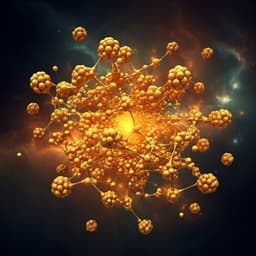
Engineering and Technology
In situ atomic observations of aggregation growth and evolution of penta-twinned gold nanocrystals
M. Song, D. Zhang, et al.
This groundbreaking study by Miao Song and colleagues explores the atomic-scale mechanisms behind the aggregation and evolution of penta-twinned gold nanocrystals, revealing how surface diffusion impacts nanoparticle morphology and promotes symmetrical formation. Their findings open new avenues for controlling twinned particle configurations in functional nanomaterial synthesis.
~3 min • Beginner • English
Introduction
Understanding nanoparticle growth mechanisms is critical for controlling size, morphology, and properties of nanomaterials in both natural and synthetic systems. Classical crystal growth models emphasizing monomer diffusion and surface reactions do not fully explain many observed behaviors; nonclassical, particle-mediated pathways such as oriented attachment, nearly oriented attachment, and non-oriented attachment (including aggregation with grain-boundary/surface-atom migration) have increasingly been recognized but remain challenging to resolve at atomic spatiotemporal resolution. Five-fold twinned (5-FT) nanoparticles are prevalent across natural and synthetic systems and exhibit unique properties arising from their crystallographically forbidden pentagonal symmetry and intrinsic lattice strain. Yet, their small thermodynamically stable size (≈3–14 nm), complex five-twin-unit configuration, motion under observation, and a limited [110] viewing direction complicate atomic-scale mechanistic studies. The research goal is to elucidate size-dependent, configuration-dependent aggregation growth mechanisms of 5-FT nanoparticles with single-crystal (SC) and 5-FT partners, disentangling the roles of surface diffusion, partial-dislocation-mediated twin-boundary (TB) migration (twinning/de-twinning), relative slip, and interface evolution. The study employs in situ high-resolution TEM and atomistic MD simulations to reveal the mechanisms and establish critical size ratios governing the final twin symmetry.
Literature Review
Nonclassical particle-based growth mechanisms include oriented attachment (OA), nearly OA (mesocrystal formation, dislocation-induced tilt attachment), and non-OA routes (intraparticle growth, transformations from metastable to stable phases, and aggregation dominated by grain-boundary/surface atom migration). Prior studies have observed particle attachment-driven crystallization in synthetic, biogenic, and geologic contexts and detailed OA direction-specific interactions. In situ TEM has challenged classical models, showing atomistic diffusion, interfacial rearrangements, and coalescence phenomena in noble metal nanoparticles. Five-fold twinned nanoparticles have long been documented and exhibit enhanced mechanical, catalytic, and optical properties linked to twin boundaries and strain. Thermodynamic analyses and experiments indicate 5-FT stability within a narrow size window (≈3–14 nm), with strain-energy considerations (e.g., formation of re-entrant {111} facets, decahedral motifs) governing morphology. Strain distributions and relaxation via TB migration and defect formation have been reported. Collectively, this literature establishes the significance of nonclassical, particle-based growth and the special role of 5-FT strain and twin structure, motivating in situ, atomic-resolution studies of aggregation growth and twin evolution.
Methodology
Nanoparticle synthesis and preparation: Au nanoparticles were synthesized via the TDAB method using HAuCl4·3H2O, TDAB, NaBH4, and 1-dodecanethiol in toluene. After reduction and ligand addition, products were precipitated and collected by centrifugation. The as-prepared dispersion (≈3.5 ± 0.6 nm, SC-dominated) was either stored in the dark for ~2 months (yielding ≈4.4 ± 1.4 nm with ~1/3 evolving to 5-FT) or cleaned repeatedly to partially remove ligands (promoting aggregation and size growth to ≈6.2 ± 2.6 nm). Samples were drop-cast on TEM grids. Particle sizes were statistically analyzed over >300 particles per condition.
In situ HRTEM: Aggregation was induced by electron-beam-driven ligand decomposition to trigger particle attachment. Imaging was performed on a 300 kV aberration-corrected TEM (Spectra 300) at a frame rate of ≈0.5 s and dose rate of (2–4)×10^6 e nm−2 s−1. Symmetric 5-FT (S5-FT) was defined when the ratio of the longest to shortest TB length <2.0; otherwise the nanoparticle was classified as asymmetrical 5-FT (AS5-FT). Terminal configurations were recorded when changes became negligible within 20 s (typical experiments ≈150–200 s). TB migration directions and partial dislocation slip were inferred from sequential image comparisons.
MD simulations: Atomistic simulations (LAMMPS) used an EAM potential for Au (Ackland et al.) with Nosé–Hoover thermostat at 1100 K and 1 fs timestep. Two model families were constructed: Model 1 (5 nm decahedral 5-FT, 1773 atoms) attached to SC NPs of 2.6 nm (811 atoms), 3.8 nm (1862 atoms), or 4.8 nm (4033 atoms), all in 20 nm periodic boxes; Model 2 (same 5 nm 5-FT) attached to 5-FT NPs of 3.2 nm (569 atoms), 4.1 nm (1061 atoms), or 5.0 nm (1773 atoms). Simulation durations were typically up to 30 ns, extended to 80 ns when sealed twin-boundary regions stabilized the configuration. Visualization and analysis employed OVITO, tracking TB migration, partial dislocations, relative slip, surface morphology, and system energy evolution.
van der Waals force calculations: To compare interaction strengths for 5-FT/SC versus 5-FT/5-FT pairs, vdW interactions were computed with a Hamaker approach. Each nanoparticle was discretized into cubes of edge length 0.2882 nm (nearest Au–Au spacing). Pairwise cube–cube London-vdW energies were integrated with geometric corrections and summed to obtain total interaction energy as a function of interparticle separation. The force was evaluated by finite difference of energy with respect to separation (Δd = 0.05 nm).
Key Findings
- In situ HRTEM and MD reveal two dominant mechanisms during aggregation growth involving a 5-FT nanoparticle: (i) surface diffusion from the smaller partner to the larger 5-FT, and (ii) partial-dislocation–mediated twin-boundary (TB) migration leading to de-twinning.
- 5-FT + SC aggregation:
• For small size ratios (R = size of SC/size of 5-FT) below ≈0.76–0.83, surface diffusion dominates, transferring atoms from the SC to the 5-FT. This produces S5-FT or AS5-FT that can further symmetrize; experiments include R = 0.58 and 0.73, MD includes R = 0.52 and 0.76. Re-entrant {111} facets form, reducing lattice strain with minor surface-energy cost.
• For larger size ratios (e.g., R ≈ 1.10), the process begins with surface diffusion and transitions to TB migration driven by nucleation and glide of partial dislocations, leading to de-twinning of the 5-FT and eventual single crystal formation.
• MD at R = 0.96 shows three stages: initial relative slip; TB-migration–dominated de-twinning via partial dislocations; final surface-diffusion–dominated de-twinning when residual twin units are only a few (111) layers thick.
- 5-FT + 5-FT aggregation:
• For small size ratios (R ≲ 0.64–0.72), surface diffusion and mutual diffusion dominate, and the larger 5-FT remains symmetric; the smaller 5-FT de-twins, yielding an S5-FT final structure.
• At intermediate/large ratios (R ≈ 0.78–1.0), relative slip, sealed TB regions, and TB migration lead to AS5-FT or complex twin structures. Experiments at R ≈ 0.78 produce AS5-FT; at R ≈ 0.82, a sealed TB region forms and later destabilizes into a complex twin. MD at R = 1.0 shows a long-lived sealed region followed by rapid TB disappearance within 0.02 ns and AS5-FT formation.
- Critical size-ratio thresholds for maintaining symmetric 5-FT after aggregation with a 5-FT core (size of partner B relative to 5-FT A):
• SC/5-FT: R < ≈0.83 tends to yield S5-FT; R ≳ 1 can de-twin to SC.
• 5-FT/5-FT: R < ≈0.72 tends to yield S5-FT; larger R favors AS5-FT or complex twins.
- Energy evolution: Strong energy drops accompany early surface-diffusion–driven reshaping and TB-migration–driven de-twinning (reducing TB and strain energies). Energy change is moderate once twins are removed or minimized.
- TB migration mechanics: Effective TB migration layers during de-twinning can be anisotropic (e.g., TBs 23₁ and 23₂ migrate 4 layers; TBs 23₃ and 23₅ migrate 5; TB 23₄ unchanged). Dislocation reactions in five coupled Thompson tetrahedra explain how a partial (e.g., Cβ′) nucleated at the periphery can generate coupled partials across units to move multiple TBs and translate the twin pole while maintaining near overlap.
- Morphological signatures: Formation of re-entrant {111} surfaces and concave/convex-dependent dominance of TB migration versus surface diffusion during the final de-twinning stages.
- Interaction forces: vdW interactions are stronger for 5-FT/SC than 5-FT/5-FT pairs due to greater numbers of close atomic contacts, reducing the driving force on a small 5-FT to migrate TBs and helping preserve symmetry in SC/5-FT aggregation at small R.
- Size regime: All observed/simulated particles are <10 nm; within 3–14 nm, 5-FT is thermodynamically favorable, and its inherent strain can be relieved via TB migration, defect formation, or re-entrant decahedral morphologies.
Discussion
The study clarifies how size ratio and twin configuration dictate the competition between surface diffusion and TB-migration–driven de-twinning in aggregation growth involving five-fold twinned nanoparticles. When the partner is significantly smaller, surface diffusion transports atoms from the small nanoparticle onto far twin units of the larger 5-FT, reinforcing symmetry and promoting re-entrant {111} facets that relieve strain. As size ratio increases, relative slip and partial-dislocation nucleation at concave regions trigger coordinated TB migration, translating the twin pole and progressively de-twinning the 5-FT. Whether the final stages are TB-migration– or surface-diffusion–dominated depends on whether the twin pole approaches convex or concave regions, respectively. The derived critical ratios (≈0.83 for SC/5-FT and ≈0.72 for 5-FT/5-FT) quantitatively map size effects onto final symmetry outcomes (S5-FT, AS5-FT, complex twins, or SC). Energy trajectories corroborate the mechanistic sequence: initial energy rises during relative slip, followed by sharp drops during de-twinning or rapid surface reshaping that reduce TB and strain energies. Stronger vdW interactions for 5-FT/SC relative to 5-FT/5-FT further explain why symmetric 5-FT can persist against TB migration when paired with a slightly larger SC, whereas 5-FT/5-FT pairs more readily undergo complex twin evolution. These insights directly address the hypothesis that the coupling of thermodynamic strain relief and kinetic pathways (surface diffusion versus dislocation-mediated TB motion) governs nonclassical aggregation growth of 5-FT nanocrystals, and they provide predictive criteria for directing final structures via particle-size selection and pairing.
Conclusion
In situ HRTEM combined with MD simulations reveals that aggregation growth of five-fold twinned Au nanoparticles is governed by a size-ratio–dependent interplay of surface diffusion and partial-dislocation–mediated TB migration. For attachment to smaller partners (SC: R < ≈0.83; 5-FT: R < ≈0.72), surface diffusion from the small particle onto the larger 5-FT dominates, stabilizing or producing symmetric 5-FT and lowering system energy. When attaching to larger SC particles (R ≳ 1), TB-migration–driven de-twinning can convert the 5-FT to a single crystal. When attaching to larger 5-FTs (R > ≈0.72), intricate twin structures emerge after stages of relative slip, sealed TB regions, and rapid TB annihilation. These mechanistic rules and critical thresholds offer practical guidance for deterministic synthesis and post-synthetic manipulation of twinned nanomaterials. Future research could: extend to different materials systems (e.g., Pd, Pt) and ligand chemistries; quantify beam-free aggregation pathways in liquid or cryo environments; explore larger size regimes beyond 10 nm to refine critical ratios; and integrate continuum or data-driven models with atomistic simulations to predict aggregation outcomes under diverse thermodynamic and kinetic conditions.
Limitations
Elevated MD temperatures (1100 K) accelerate kinetics and produce transient surface amorphization not observed under experimental conditions, potentially affecting detailed mechanistic pathways and timescales. Electron-beam–induced ligand decomposition drives aggregation in TEM, which may alter kinetics and energetics compared to solution-phase or beam-free environments. Critical size-ratio thresholds were established for sub-10 nm particles and may shift with larger sizes or different shapes/surface chemistries. Most quantitative simulations and experiments focused on Au; generalization to other metals (e.g., Pd, Pt) requires verification. Temporal and spatial resolution limits in HRTEM can obscure ultrafast events (e.g., dislocation nucleation) and subtle mutual diffusion without morphology changes.
Related Publications
Explore these studies to deepen your understanding of the subject.







